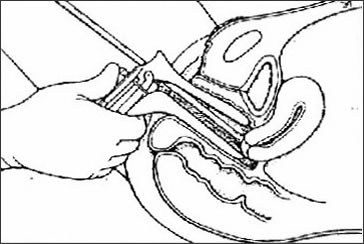A speculum is a device used to look inside the vagina and check the cervix and do a Pap Papanicolaou smear. There are a number of shapes and sizes of speculums they may use. The two major types are called Graves and Pederson. The Graves are wider in the bill than the Pederson, and the Pederson is more tapered. Before inserting the speculum, the doctor should alert you that the speculum examination is about to begin. Take a breath and exhale.
Speculum Examination
The doctor will now perform the speculum exam. There are a number of shapes and sizes of speculums they may use. The two major types are called Graves and Pederson. The Graves are wider in the bill than the Pederson, and the Pederson is more tapered. The Graves is generally used for sexually active women and the Pederson is preferred for the woman with a "relatively small introitus, such as a virgin or an elderly woman, and is often more comfortable for other patients as well" (Bates Guide to Physical Examination, 7th edition). Both Graves and Pederson come in metal and plastic and in small, medium and large sizes. A fiber optic light can be inserted into a plastic speculum to optimize visibility of the vaginal walls. There are also some special products for pediatrics and for obese patients.
|
|
|
| Pederson Vaginal Speculum | Graves Vaginal Speculum |
Once the doctor has chosen the appropriate speculum, they should check it mechanically. The screw at the handle adjusts the height of the opening. This should be adjusted and tightened before insertion. The lever can be depressed to open the bills, and the screw at the lever holds them in place in the open position. This screw at the lever should be loose when inserting the speculum and the bills should be closed.
If this is your first pelvic exam, the doctor should show you the speculum. If they do not you can still ask to be shown the speculum. The doctor always holds the speculum with their index finger over the top of the bills, their other three fingers underneath and around the handle, and the thumb underneath the lever. Most doctors check to see that the speculum is not too cold. The temperature of the speculum can be checked by touching it against the inside of your thigh. If it is too cold, the doctor can run it under warm water. Some doctors keep their speculums in warm water.

Before inserting the speculum, the doctor should alert you that the speculum examination is about to begin. Take a breath and exhale. The doctor should re-establish the tactile signal and insert it at a 45-degree angle. As they slowly insert the speculum more fully, they rotate it to a flat position so that the handle is perpendicular to the floor. The bills should remain closed as they insert the speculum. The doctor will then push the speculum in gently until they feel some resistance. They should not force it in, but they also want it to be deep enough that they are able to see the cervix when they open the bills. Once the speculum is in far enough, they hold the handle with one hand to hold it in place. They slowly depress the lever to open the bills with the other hand until they are able to see the cervix. You may feel your cervix fall into place as the speculum is opened. It is not painful but slightly uncomfortable.
Once they have the cervix in view, they tighten the screw on the lever enough that it holds the bills open. At this point, with the bills open, the speculum will stay in place and the doctor should have the cervix in view and visually examine it, size, color, and configuration of the OS (center/opening). If all appears normal then the doctor should reassure you. This is an opportune time to use the hand held mirror to view your own cervix.
This is when the doctor takes cultures for the Pap smear, they should alert you that you will feel some pressure and discomfort, but no pain as they gently swipe off the cultures from your cervix. They will now remove the speculum with bills open until it is free of the cervix. Then they will allow it to close partially and rotate it to a 45-degree angle, observing the vaginal walls. The speculum will close completely as it is fully removed


